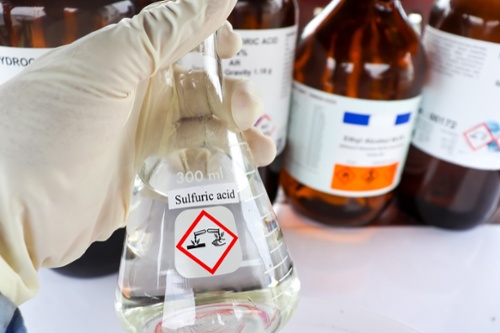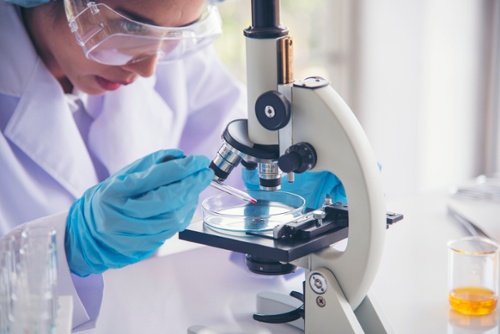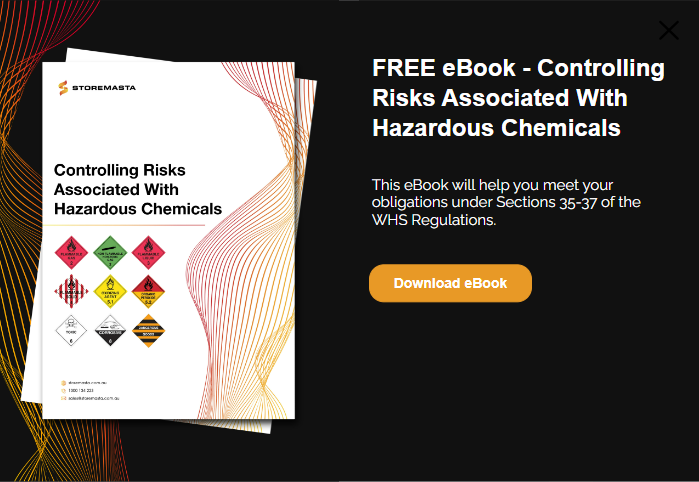Like many Australian workplaces, a laboratory environment involves the use and storage of chemicals, including dangerous goods of various classes. However, the compact nature of most laboratory environments, and the proximity of hazardous chemicals to the people handling them, necessitate a specially developed set of guidelines for the storage of chemicals in laboratories and their supporting storage facilities. We’ll detail the chemicals commonly found in laboratories, the risks associated with each dangerous goods class, and the storage and handling precautions required to control these risks.
Chemicals Used in Laboratories
Chemicals commonly used in laboratories include a range of hazardous substances, as defined by Safe Work Australia, as well as a variety of dangerous goods — many of which are classified under the current ADG Code.
Flammable liquids such as methanol are commonly used in labs for a variety of purposes.
Laboratories also commonly use a range of chemicals that may not be classified as hazardous substances or dangerous goods but can present compatibility problems when stored incorrectly.
In the next section of our post, we’ll look at some of the most commonly used lab chemicals and explain the dangerous goods classes of these substances.
Flammable Liquids Used in Laboratories
Some of the most prevalent chemicals found in Australian laboratories are those designated as Class 3 - Flammable Liquids.
Some common examples of flammable liquids include:
- Acetone - (CH3)2CO - also called propanone, used in laboratories as a polar, aprotic solvent in a variety of organic reactions, as well as to precipitate proteins, and as a fluorescent tracer in fluid flow experiments.
- Benzene - C6H6 - classed as a hydrocarbon, this common industrial chemical is used primarily as an intermediate to make other chemicals, including acetone and ethylbenzene, which is used to make polymers and plastics.
- Cyclohexane - C6H12 - another common industrial chemical mainly used in nylon production; commonly used in laboratories as a recrystallisation solvent, and for calibration of differential scanning calorimetry (DSC) instruments.
- Ethanol - C2H6O - also called ethyl alcohol, grain alcohol, or simply alcohol when referring to alcoholic beverages; used in labs as a chemical solvent, in the synthesis of organic compounds, and (with dry ice or other coolants) as a cooling bath due to its low freezing point
- Methanol - CH3OH - also called methyl alcohol or wood alcohol, used industrially as a base product for manufacturing chemicals such as formaldehyde, which is used in the production of plastics, paints and explosives; used in laboratories mainly as a solvent.
- Pentane - C5H12 - the most volatile of the liquid alkanes at room temperature, pentane is relatively cheap and evaporates rapidly, so is often used in laboratories as a specialty solvent; also used in liquid chromatography.
Gases Used in Laboratories
Class 2 - Gases are used in Australian labs for a variety of purposes such as gas chromatography. The risks associated with the storage and handling of gas, generally involving gas cylinders, are manifold and must be managed properly to avoid damage to people and property.
Gases used in laboratories include:
- Gas chromatography (GC) carrier gases - such as helium, nitrogen and hydrogen
- Atomic absorption (AA) gases - such as nitrous oxide (NO2) and acetylene (C2H2)
- Flame ionisation detection (FID) gases - such as hydrogen or hydrogen mixtures, other fuel gases, and even ai
- Supercritical and coolant gases - such as liquid nitrogen and carbon dioxide (CO2)
- Inductively coupled plasma (ICP) gases - such as argon, both compressed and in liquid form
- Electron-capture detection and nuclear counter mixtures - including methane-argon mixtures
Flammable Solids Used in Laboratories
Class 4 - Flammable Solids such as carbon, sulphur and phosphorus are prone to spontaneous combustion. Flammable solids classified as Dangerous When Wet, such as alkali metals, activated carbon, and aluminium phosphide, can emit flammable gases when they come into contact with water, and must be stored appropriately with adequate ventilation.
Class 4 - Flammable solids used in labs are divided into three subdivisions and include:
- Class 4.1 - Flammable Solids, such as nitrocellulose used in membrane filters and diagnostics; and magnesium, used in organic synthesis.
- Class 4.2 - Spontaneously Combustible Solids, such as aluminium alkyls used in chemical synthesis; and pyrophoric substance.
- Class 4.3 - Dangerous When Wet, solid substances that emit a flammable gas when wet or react violently with water, such as sodium, calcium, potassium and calcium carbide (CaC2).
Oxidising Substances and Organic Peroxides Used in Laboratories
Class 5 - Oxidising Substances and Organic Peroxides differ in that the former are non-combustible while the latter may combust independently.
![]() Class 5.1 cabinets are ideal for the indoor storage of oxidizing agents.
Class 5.1 cabinets are ideal for the indoor storage of oxidizing agents.
Oxidising substances and organic peroxides used in labs include:
- Class 5.1 - Oxidising Agents such as hydrogen peroxide (H2O2), halogens, potassium nitrate (KNO3), and nitric acid (HNO3).
- Class 5.2 - Organic Peroxides such as methyl ethyl ketone peroxide (MEKP) (C8H18O6).
Toxic Substances Used in Laboratories
Dangerous goods used in labs can be either toxic or non-toxic, as well as exhibiting other hazards associated with other Dangerous Goods classifications.
A powerful oxidiser such as hydrogen peroxide, for example, is also corrosive and toxic, but has a greater oxidising ability than corrosion ability or toxicity and is therefore given a Class 5.1 Dangerous Goods classification (hydrogen peroxide also has a subsidiary hazard classification of Class 8 to cover its significant corrosive ability).
Class 6.1 - Toxic Substances used in laboratories include:
- Methylene chloride - CH2Cl2 - (also called dichloromethane); isopropyl alcohol (C3H8O); and hydrogen peroxide (H2O2)
Corrosive Substances Used in Laboratories
Class 8 - Corrosive Substances used in labs include acids and bases.
Acids Used in Labs
Sulfuric acid (H2SO4), hydrochloric acid (HCl), nitric acid (HNO3), citric acid (C6H8O7)
Bases Used in Labs
Sodium hydroxide (NaOH), calcium hydroxide (Ca(OH)2), sodium carbonate (Na2CO3), aluminium hydroxide (Al(OH)3)

Acids are a chemical commonly found in laboratories.
Miscellaneous Dangerous Goods Used in Laboratories
Class 9 - Miscellaneous Dangerous Goods used in laboratories include:
- Solid carbon dioxide (CO2), or dry ice
- Acetaldehyde ammonia - C6H15N3
- Zinc dithionite, or zinc hydrosulphite - O4S2Zn
How to Identify Hazards and Manage Risks in the Laboratory
There’s a myriad of ways to injure yourself or damage equipment in a laboratory environment, and the presence of potentially dangerous chemicals is one of the major hazards lab workers face on a daily basis.
It’s essential to identify and manage the risks to health and safety associated with using, handling, generating and storing hazardous chemicals in a laboratory. Controlling chemical risks is an intrinsic part of your duties under the current model Work Health and Safety (WHS) Regulations.
Ensure Safety Data Sheets (SDSs) are Accessible
The model Code of Practice: Managing risks of hazardous chemicals in the workplace provides practical guidance on how to manage health and safety risks.
If hazardous chemicals are not stored and handled in ways that comply with these codes and regulations, damage to people and property are more likely to occur, potentially ruining businesses, careers and people’s lives.
One of the first steps the code stipulates for managing chemicals in the workplace is to ensure all the hazardous chemicals stored on the premises each has a readily accessible, relevant Safety Data Sheet (SDS) that anyone can refer to for critical information about the hazardous chemical.
The SDS includes information on:
- The chemical's identity and ingredients.
- Health and physical hazards.
- Safe handling and storage procedures.
- Emergency procedures.
- Disposal considerations.
Conduct a Risk Assessment
Although not mandatory under WHS Regulations, a risk assessment is the most effective way to identify the hazards and control risks in the laboratory from dangerous chemicals.
A risk assessment will help you:
- Identify which laboratory workers are at risk of exposure.
- Determine what sources and processes are causing that risk.
- Identify if and what kind of control measures should be implemented.
- Check the effectiveness of existing control measures.
How to Comply With the WHS Act and WHS Regulations
An approved Code of Practice provides practical guidance on how to comply with the standards of workplace health and safety as set out in the WHS Act and WHS Regulations.
As with other Australian workplaces, laboratories and the people working within them have specific duties under the model WHS Regulations to manage the risks to health and safety associated with using, handling, generating and storing hazardous chemicals at a workplace.
These duties include:
- Ensuring that all containers (and pipework) are labelled correctly with appropriate warning placards and safety signage
- Maintaining a register and manifest (if manifest quantities are involved) of hazardous chemicals used or stored in or outside the laboratory
- Notifying the regulator if manifest quantities of hazardous chemicals are stored on site
- Identifying the potential risks of chemical or physical reactions of hazardous chemicals and ensuring these chemicals remain stable
- Ensuring lab technicians and other workers are not exposed to hazardous chemicals in a manner that exceeds workplace exposure standards
- Ensuring lab staff have access to health monitoring facilities if required
- Providing lab staff with adequate information, training, instruction and supervision
- Putting in place suitable spill containment systems for any hazardous chemicals used in the lab or storage area
- Ensuring the relevant Safety Data Sheet (SDS) is securely stored and easily accessible
- Maintaining control of ignition sources as well as the accumulation of flammable and combustible substances
- Ensuring the provision of fire protection and firefighting equipment, and emergency and safety equipment
How to Follow the Model Code of Practice
The model Code of Practice: Managing risks of hazardous chemicals in the workplace provides guidance on how to manage the specific risks associated with hazardous chemicals in the workplace.
The Code advocates using the following systematic methodology:
- Identify any potential hazards - focus on what could harm people, property or the environment.
- Assess the risks - unless dealing with known risks with known controls, you must work out what type of harm the hazardous chemicals could cause, as well how serious the harm could be and the likelihood of it occurring.
- Eliminate the risks - as much as it is reasonably practicable to do so given the chemicals involved.
- Control the risks - if eliminating the risk is not reasonably practicable, implement the most effective control measures (that are reasonably practicable in the circumstances) according to the hierarchy of control measures, and ensure they remain effective.
- Sustain - review the control measures regularly to ensure they are still working
Australian Standard for Safety in Laboratories - Storage of Chemicals
Another authoritative source of information specific to ensuring safety in laboratories is a series of standards - AS/NZS 2243 - Safety in laboratories - published by Standards Australia that focus on promoting safe working practices in laboratories.
Part 10 of the AS/NZS 2243 series (AS/NZS 2243.10:2004 - Safety in laboratories - Storage of chemicals) is dedicated to the appropriate storage of chemicals and dangerous goods both within laboratories and within dedicated storage areas that are support areas for a laboratory.
The Standard covers the basic principles of storing chemicals to ensure the safety of people, property and the environment both inside and outside the laboratory.
Dangerous goods from Class 1 (Explosives), Class 6.2 (Infectious substances), and Class 7 (Radioactive substances) are not covered by this Standard but are covered in other parts of the AS/NZS 2243 series.
Storage of chemicals outside the laboratory entails a choice of risk control measures dependent on the class or mixed classes of dangerous goods involved. The choices include the undertaking of a risk assessment to determine which control measure should be applied for that particular chemical storage scenario.
Isolation and Engineering Controls
As per the Hierarchy of Controls, there is a system involved with controlling chemical hazards – running from the most effective to the least effective of controls.
In this part of our post, we’ll be focusing on the engineering controls that are best suited to laboratories.
Isolation Controls in the Laboratory
Isolating hazardous chemicals from people and other chemicals (or things) that are incompatible is mandatory.
Isolation can be achieved using distance, barriers and appropriate chemical storage facilities.
Examples of isolating lab workers from hazards includes the use of fume hoods with exhaust extraction capabilities to remove dangerous airborne hazards from the work area or using closed or sealed systems for chemical dispensing and transfer.
Isolating hazardous chemicals from other chemicals — also called segregation of chemicals — is achieved by using distance, barriers or a combination of both.
Incompatible hazardous substances can be easily segregated by storing them in separate chemical storage cabinets.
Engineering Controls in the Laboratory
If isolation of the hazardous chemicals is not possible or falls short of the required standards, there are engineering controls that should be implemented.
These controls are physical in nature and include devices or processes that eliminate or minimise exposure to the hazards. Use engineering controls to:
Minimise the generation of hazardous chemicals.
- Suppress or contain hazardous chemicals.
- Minimise the impact of contamination in the event of a spill.
Engineering controls include mechanical ventilation systems, compliant chemical storage containers or the automated processes involving hazardous chemicals.

Compliant storage is a necessary control to minimise chemical hazards.
Engineering Controls: Enclosed Storage
To meet the requirements for the Standards covering the storage and handling of chemicals in the laboratory, certain dangerous goods will need to be securely stored in compliant chemical storage cabinets.
Indoor chemical storage cabinets are designed to:
- Protect the contents of the cabinet against damage.
- Ensure segregation between incompatible substances.
- Contain spills.
- Allow a minimum of 10 minutes for people to escape or access firefighting equipment in the event of fire.
Some dangerous goods require cabinets made from chemically-resistant materials to prevent corrosion. For example, harsh corrosive chemicals, such as sulphuric acid, can cause significant damage to metal surfaces. This is why laboratory-strength concentrations of this acid should be stored in cabinets constructed from high-density polyethylene to prevent corrosion of the storage equipment.
IMPORTANT: Storing corrosives? Find out the difference between a steel and polyethylene corrosive substance storage cabinet by reading our popular blog.
Chemical Cabinet Location
The location of chemical storage cabinets is also a key factor in minimising the risks these hazardous chemicals present. They must not be stored:
- Above or below each other.
- Closer than 3 metres from any emergency escape routes.
- Under stairwells or in corridors.
- Within 3 metres of an ignition source.
Where laboratory cupboards are used to store hazardous chemicals, their construction and the materials used must be compatible with the chemicals. Spill trays should also be in place as well as adequate ventilation where required.
Engineering Controls: Open Storage
Where hazardous chemicals are kept on shelves or racks in a laboratory, the following restrictions apply:
- For shelves over benches, the chemical must not be stored on shelves higher than 1.5 metres from the floor.
- The shelving and fixtures must be compatible with the dangerous goods being stored, or be suitably protected from those goods.
- The shelves’ maximum holding capacity must not be exceeded - To support effective housekeeping, chemical packages should not be stored on the floor.
- Shelving used for storing chemical storage should not be subject to any lateral movement.
To reduce the risk of contamination, liquids should not be stored above solids. Therefore, liquids should be stored as low as possible to reduce the risk of breakage and spillage, with adequate bunding provided.
Chemical Controls and your Lab
When working in a laboratory setting, there are multiple chemical hazards to control. However, due to the various Dangerous Goods classes present, segregation of incompatible susbtances, safe handling procedures, adequate ventilation and compliant chemical storage are key considerations. However, before you introduce new chemicals into your laboratory, we highly recommend you conduct a risk assessment so you can properly identify, assess and control the hazards in your workplace.
Our team have developed an eBook explaining how to control the risks associated with hazardous chemicals such as those used in labs. This free eBook helps you select the most effective risk control measures and implement all the required mandatory controls according to current legislation.Get your copy today to find out more.
Joining the team as a Dangerous Goods Storage Consultant, Melissa Hampton became Storemasta's Marketing Manager in late 2021. With extensive knowledge and experience in chemical compliance, Melissa is responsible for leading the Marketing team and helping shape their marketing strategy. In her spare time, you can find Melissa hiking, swimming and enjoying the great outdoors in beautiful north-west Tasmania.
